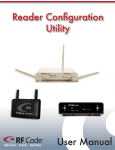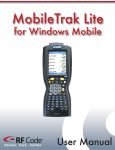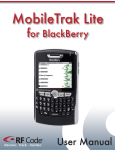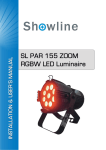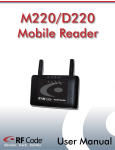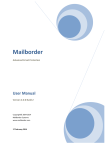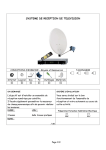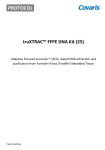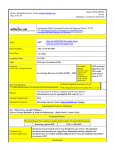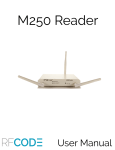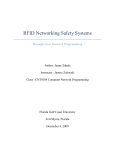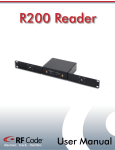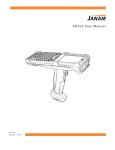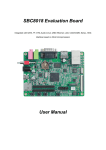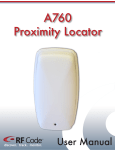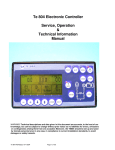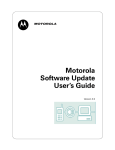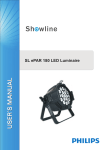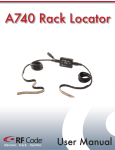Download User Manual for Windows Mobile
Transcript
MobileTrak for Windows Mobile discover. track. monitor. User Manual Contents Preface 3 3 3 MobileTrak 4 4 4 4 5 5 5 8 12 15 15 15 15 16 17 18 19 19 22 23 Warranty & Service 24 24 24 24 24 Trademarks Copyright Statement Introduction Requirements Features Installation Connecting to Reader Microsoft Bluetooth Stack Broadcom’s Widcomm Bluetooth Stack Configuration Setup Launching Application Configuration Screen Options Select Reader About MobileTrak Diagnostic Mode Start Inventory Job Inventory Job Screen Tag Search Select Asset Category Select Zone Category Stop and Complete Jobs Limited Standard Warranty Terms Standard Warranty Limitations Obtaining Service & Support RF Code Customer Support PN00555 REV02 MobileTrak User Manual 2 Preface Trademarks RF CodeTM and the RF Code logo are trademarks of RF Code, Inc. Windows is a registered trademark of Microsoft Corporation in the United States and other countries. The Bluetooth® word mark and logos are registered trademarks owned by Bluetooth SIG, Inc. and any use of such marks by RF Code is under license. Broadcom’s Widcomm® Bluetooth Stack is a registered trademark of the Broadcom Corporation. All other product or service names are the property of their respective owners. Information in this document is provided solely to enable system and software implementors to use RF Code products. There are no express or implied copyright licenses granted hereunder to design or fabricate any integrated circuits or integrated circuits based on the information in this document. RF Code reserves the right to make changes without further notice to any products herein. RF Code makes no warranty, representation or guarantee regarding the suitability of its products for any particular purpose, nor does RF Code assume any liability arising out of the application or use of any product, and specifically disclaims any and all liability, including without limitation consequential or incidental damages. The user of this system is cautioned that any changes or modifications to this system, not expressly approved by RF Code, Inc., could void the warranty. Bluetooth® QD ID: B012541 Copyright Statement Copyright © 2008-2009 RF Code, Inc. All Rights Reserved. This document, as well as the hardware and firmware described therein, is furnished under license and may only be used or copied in accordance with the terms of such license. The information in these pages are furnished for informational use only, are subject to change without notice, and should not be construed as a commitment by RF Code, Inc. RF Code assumes no responsibility or liability for any errors or inaccuracies that may appear in these pages. Every effort has been made to supply complete and accurate information. However, RF Code assumes no responsibility for its use, or for any infringements of patents or other rights of third parties, which would result. RF Code, Inc. 9229 Waterford Centre Blvd. Suite 500 Austin, TX 78758 www.rfcode.com PN00555 REV02 MobileTrak User Manual 3 MobileTrak Introduction MobileTrak is designed for use with the M210 and M220 Mobile Readers, and enables mobile inventory collection of very large numbers of RF Code tags and tagged assets. MobileTrak is designed to work as a standalone inventory tracking/inventory collection application that does not require a specific back-end server to manage asset data. Instead, MobileTrak exports data in common formats for use with a broad variety of applications. MobileTrak enables users to inventory and search thousands of tagged assets using a simple to use and understand graphical interface. MobileTrak makes inventorying large numbers of assets quick and painless. Using customizable job inventory definitions, MobileTrak gathers data about all RF Code tags the reader encounters. Users can browse the collected tag data, ”drilling-down” into the data gathered from each tagged asset to examine details or to add information about the location and status of the asset. Stored tag inventory data can be saved, exported, or e-mailed for later use. MobileTrak also enables users to set the antenna range setting to one of the 8 preset modes. And when searching for a specific tagged asset MobileTrak reports signal strength indication (SSI) values to provide visual and audible alerts to indicate proximity. Requirements MobileTrak prerequisites: • Touch screen capability (the device has a stylus) • One of the following: ◊ Bluetooth Wireless support (for connectivity to the M220 Mobile Reader) ◊ PC Card slot (for the M210 PC Card Reader) • Required Operating System: ◊ CE.NET 4.2+ ◊ Windows Mobile Pocket PC version 5 (Premium Edition, Professional Edition, Phone Edition) ◊ Windows Mobile version 6 (Professional Edition, Classic Edition) • .NET Compact Framework version 2.0 SP2 (or higher) Compatibility issues: • MobileTrak will NOT work with Windows Mobile 5 for Smartphones • MobileTrak will NOT work with Windows Mobile 6 Standard • All Windows Mobile 6 Professional and Classic devices come with the .NET Framework 2.0 or later. • Many Windows Mobile 5 devices come with an older (unsupported) version of .NET Compact Framework and may need to be upgraded. See the following Microsoft Web page about upgrading the .NET Compact Framework: ttp://www.microsoft.com/downloads/details.aspx?familyid=AEA55F2F-07B5-4A8C-8A44h B4E1B196D5C0&displaylang= Features Some of the features included with the MobileTrak are: • Inventory and manage thousands of tagged assets without requiring a dedicated back-end server • Runs on mobile devices running the Windows Mobile operating system • Use Bluetooth or USB connectivity • Easily locate and inventory assets • Capable of searching up to 500 tags/MB of free RAM available PN00555 REV02 MobileTrak User Manual 4 To install the MobileTrak software on your Windows Mobile device, perform the following steps: Installation Installation 1. Ensure that you handheld device is connected to your PC through a docking station or USB cable that came with your handheld device. 2. To connect to your handheld device you will need to use Microsoft ActiveSync 4.5 (XP users) or Microsoft Windows Mobile Device Center 6.1 (Vista users) software. To download the latest versions use the following websites: • Microsoft ActiveSync - http://www.microsoft.com/windowsmobile/activesync/activesync45.mspx • Microsoft Windows Mobile Device Center - http://www.microsoft.com/windowsmobile/devicecenter. mspx 3. Install MobileTrak for Windows Mobile from the CD. If the CD autorun program does not launch the main menu, you can use Windows explorer to browse to the CD drive and double-click on the autorun file to bring up the menu. Select the appropriate menu (MobileTrak for Windows Mobile) and follow the prompts in the Setup Wizard to install the Windows Mobile version of the MobileTrak application. Connecting to Reader Before you can begin using the MobileTrak application with your handheld device, you must first setup a connection to your M220 Mobile Reader that is part of the RF Code mobile tracking solution. To do this you must pair the Bluetooth enabled M220 Mobile Reader to your handheld device. Depending on the type of handheld device you are using, there are two different methods of pairing. To connect your reader with your handheld device, follow one of the two methods below: Microsoft Bluetooth Stack 1. Access the Bluetooth Manager on your handheld device by navigating to Start>Settings>Connections>Bluet ooth, and tap Add New Device. (Figure 1). Figure 1 Add New Bluetooth Device PN00555 REV02 5 2. The Bluetooth Manager will automatically generate a list of Bluetooth enabled devices. Select your Reader and tap Next. (Figure 2). Figure 2 Select M220 Reader in Bluetooth Device List 3. Enter the passkey (the default is 0000) and tap Next as seen in (Figure 3). Figure 3 Enter Passkey 6 PN00555 REV02 Connecting to the Reader Introduction 4. Check the Serial Port box and tap Finish. (Figure 4). Figure 4 Select Serial Port 5. Your reader will now show up as a Bluetooth paired device. Tap OK to exit the Bluetooth Manager. (Figure 5). Figure 5 Bluetooth Paired Reader PN00555 REV02 7 Broadcom’s Widcomm® Bluetooth Stack 1. Access the Bluetooth Manager on your handheld device by navigating to Start>Settings>Connections>Blueto oth>Bluetooth Manager, and tap on the Active Connections tab. (Figure 6). Figure 6 Bluetooth Manager Active Connections Screen 2. Create a New connection by taping on Menu>Paired Devices. (Figure 7). Figure 7 Add Bluetooth Paired Device 8 PN00555 REV02 Connecting to the Reader Introduction 3. Tap the Add button and the following screen will display (Figure 8) Figure 8 Add New Bluetooth Device 4. Tap the Search icon to the right of the Device box, and a list of Bluetooth enabled devices will automatically be found by your handheld device (Figure 9). Figure 9 Add New Bluetooth Device PN00555 REV02 9 5. Select your reader from the list, set the passkey (the default is 0000) and tap OK as seen in (Figure 10). Figure 10 Enter Passkey 6. Your reader will now appear in the in the list of paired devices (Figure 11). Tap OK to continue. Figure 6 Paired Bluetooth Devices List 10 PN00555 REV02 Connecting to the Reader Introduction 7. You must now create a shortcut to the Reader so that you can connect to it. To create a Shortcut, tap on the My Shortcuts tab and browse to New>Explore a Bluetooth Device (Figure12). Figure 12 Explore Bluetooth Devices 8. The Bluetooth Manager will automatically find the reader. Create a shortcut connection to your M220 Mobile Reader by selecting it from the list and selecting Serial Port (Figure 13). Figure 13 Create shortcut to M220 Mobile Reader PN00555 REV02 11 9. Your M220 Mobile Reader will now appear in the My Shortcuts tab. Highlight the reader and access the dropdown menu and select Connect to connect to your reader (Figure 14). Figure 14 Add New Bluetooth Device Your handheld device is now paired with your M220 Mobile Reader. You can now begin using the MobileTrak software to track and inventory your tagged assets. Configuration Setup Prior to launching the MobileTrak application, an XML configuration file must be generated for the tagged assets you intend to inventory and track. For assistance in the creation of a configuration XML file, please refer to the MobileTrakXMLSpecification.pdf document that is available on the CD provided with your software. It is very important to insert the correct Tag Group IDs and Treatment Codes in this configuration file. The group ID is printed on the label of a tag (Figure 15). A support page is available to help you determine you specific Group Code and Treatment Code at: http://www.rfcode.com/codes Figure 15 Group ID, Tag ID, and Treatment Code Location M100-M000-04A Group Code Tag ID Treatment Code 12 PN00555 REV02 Configuration Setup All RF Code tags are defined as being members of a specific group, and have a unique tag ID number within that group. When an RF Code reader is configured, it can be supplied with up to 8 group code IDs and a corresponding treatment code for each group code. The treatment code instructs the reader how to interpret the payload data for each tag event within that group code. RF Code tags are smart and have the ability to transmit various types of data within its radio frequency beacon such as indicators for motion, panic, tamper, infrared location, and low battery. The following is a list of RF Code Group Codes and their corresponding tag Treatment Codes. Most RF Code tags utilize Treatment Code 02 or 04. Treatment Code 02: • TRTTWO • INTJDS • RFCMII • EDSAMS • CUBIXX • SMYLCM • GDASST • GDLOCK • GDTAPR Treatment Code 04: • RFCLOC • AHSAAA • RFCSEC • LOCATE The list above is a compilation of the most current codes at the time of publication, however, a support page with the most updated list of group/treatment codes is available to help you determine your specific Group Code and Treatment Code: http://www.rfcode.com/codes Contact RF Code support if you have questions about the usage of group codes and treatment codes. 512.439.2200 (main), 877.969.2828 (toll-free), [email protected], or http://www.rfcode.com/support Once the XML configuration file has been generated, the file must be copied onto your handheld devices’s My Documents folder. This can be performed using the Microsoft ActiveSync (XP users) or the Microsoft Windows Mobile Device Center (Vista users) to browse to the documents folder and place the configuration XML file in this folder. Only XML files in the My Documents folder are visible by the software. PN00555 REV02 13 Figure 17 Select Reader Option Within the Select Reader Option a menu can be accessed that allows the user to select two reader options. They are described below: 1. When the About Attached Reader option is selected a screen describing the readers name, model, firmware, frequency, DSP, and MAC ID. 2. When the Add IP Reader option is selected the user can enter the IP address and port for an additional M220 Mobile Reader (Figure 18). The added reader can then be accessed and selected in the Select Reader screen to connect with. Figure 18 Add IP Reader 14 PN00555 REV02 Launching Application Launching Application After installing MobileTrak and pairing the M220 Mobile Reader to your handheld device, select and open the MobileTrak application by going to Start>Programs> MobileTrak . The initial screen is shown in Figure 16. Figure 16 MobileTrak Initial Screen The initial screen will show a list of configuration files that have been copied to your device. Configuration Screen Options In this configuration screen there are two menu options. They are describe in detail below: Select Reader This option allows the user to select an M220 Mobile Reader that they have paired with the device in the steps mentioned above. This feature can be accessed by taping on Menu>Select Reader (Figure 17) and selecting the reader from the drop down list. You have successfully selected the reader when the message “connected” appears next to the Select Reader field and you may close out of the Select Reader option. About MobileTrak Select this option if you would like to see information regarding the version of MobileTrak that you are running on your device. PN00555 REV02 15 Diagnostic Mode This feature indicates the noise level present within the immediate vicinity of the M220 Mobile Reader that the user has connected to. This feature can be accessed by highlighting the Configuration file and pressing which will bring up the Diagnostic Mode option. Select Diagnostic Mode to bring up the diagnostic screen (Figure 19). Figure 19 Diagnostic Screen Within the Diagnostic Screen, the Option menu can be selected to change the range settings affecting the Diagnostic Mode read (Figure 20). 16 PN00555 REV02 Start Inventory Job Figure 20 Diagnostic Range Setting Start Inventory Job To start an inventory job, ensure that your reader has been selected and is connected to your device running Windows Mobile. Select a configuration from the list from the initial configuration screen by tapping once on the configuration. The following screen will appear (Figure 21). Tap on the Start Job button to begin an inventory job. Figure 21 Start Inventory Job PN00555 REV02 17 Once you have started the job, you may be prompted by the Zone Selection Screen if you have if defined this in your XML configuration (See MobileTrakXMLSpecification.pdf included on the MobileTrak CD). The following screen will appear (Figure 22). Select a preset zone from the drop down menu that has been previously specified by the XML configuration as your Default Zone. Alternatively, if you do not see your desired Default Zone in the drop down menu, select New Zone and type in your desired zone name. Tap OK to continue. Figure 22 Default Zone Selection Inventory Job Screen The Inventory Job Screen will appear (Figure 23). Figure 23 Inventory Job Screen 18 There are several options available to the user in the Inventory Job Screen. These options are described in detail below: PN00555 REV02 Inventory Job Screen Tag Search Users can search for a specific tag a groups of tags if the tag ID or group code is known. Select Menu > Search and the following screen will display (Figure 24). Input the tag ID or group code and tap Search. The tag or tag group information will display. Figure 24 Tag Search Option Select Asset Category Users can select any of the asset categories that were defined by the configuration. A screen similar to the following (Figure 25) will appear when an asset category is selected. Figure 25 Asset Category Screen 72F PN00555 REV02 19 When viewing assets, each found tag is identified by its TagID and a signal strength indicator that visually denotes the proximity of the tag. Generally, stronger signals indicate the tag is closer to you and a weak signal means the tag is farther away. Also, various state indicator icons may appear with an asset tag as shown in Figure 23. These icons indicate the following: Motion icon indicates that asset is moving or being relocated. Tamper icon indicates that tag has been removed from asset. Panic icon indicates that panic button has been activated on tag. Low battery icon indicates that the tag’s battery is low and should be replaced. Dry contact icons indicate the current dry contact tag sensor is either open or closed. Sensor low battery icon indicates that tag’s sensor battery is low and should be replaced. The user can select an asset from the list in the asset category and a screen that provides detailed information about the tagged asset will appear (Figure 26). This can also be accessed by browsing to Menu>Details. Figure 26 Tag Details From this view of the Asset Details there are three options available. These options are: • Add Description: This option allows you to add a description of the tagged asset and can be accessed by tapping Menu>Add Description. Once you have typed in the description for the asset, tap OK to continue. • Add Note: This option allows you to add detailed information or a note to the particular asset. This can be accessed by tapping Menu>Add Note. Once you have finished entering the note for the tagged asset, tap OK to continue. • Beacon Sound On/Off: This option allows you to turn on/off an audible alert for each beacon of the tagged asset. This is accessed by tapping Menu>Beacons Sound On (or Beacon Sound Off). 20 Once you have completed the desired tasks for a particular tagged asset, tap OK to return to the Asset Category view. PN00555 REV02 Inventory Job Screen Within the Asset Category Screen the Add Description and Add Note options are also available without having to click on the Details view of the particular asset that is highlighted. Add Description can be accessed by highlighting the asset and browsing to Menu>Add Description. Add Note can be accessed by highlighting an asset and browsing to Menu>Add Note. Also a user can modify certain options globally for all assets in a particular Asset Category by browsing to Menu>Options (Figure 27). Figure 27 Global Options This feature allows you to customize global aspects of the MobileTrak software. These aspects are: • Range Settings: This option allows you to change the read range of the reader that you are connected to. The range has various settings, 1 through 8 with 1 being the minimum read range (less than 10 meters) and 8 being the maximum read range (70-100 meters, depending on deployment conditions). • Sound: The sound can be set to emit on a beacon from the tag, on an alert from the tag, or can be turned off. • Sort By: This option allows you to sort the tagged assets by zone, time, signal strength, or by motion, tamper, panic or low battery alerts. You can also utilize the drop down list on the main screen of the software to access the Sort By feature. • Sort Order: This option allows you to sort by ascending or descending order. • Show Zone: This option allows you to display or not display the assigned zone for tagged assets. • Color: This option allows you to change the color that displays the signal strength of the beacon from the tagged asset to either a red, blue, or green color. • Vibrate: The vibrate feature of the handheld device can be set to happen on a beacon from the tag, on an alert from the tag, or can be turned off. TIP At any point during an Inventory Job, a user can pause the job by browsing to Menu>Pause Job in the Inventory Job Screen (Figure 23). Alternatively, the user can then resume the job by browsing to Menu>Resume Job in the Inventory Job Screen. PN00555 REV02 21 Select Zone Category Within the Inventory Job Screen (Figure 23), a user can access the Zone Category (Figure 28) by selecting and holding on Zones. Figure 28 Zone Category Within the Zone Category the user can search for tagged assets by zones that have been setup with the XML configuration (Figure 29). Figure 29 Sort by Zone 22 PN00555 REV02 Stop and Complete Jobs Once the user has completed the intended Inventory Job, the job should be stopped and the resulting XML file with inventory job information will be either saved to the device or exported to a location that has been setup in the beginning XML configuration file To stop a job, browse to Menu>Stop & Complete and you will receive a confirmation message (Figure 30). If you would like to proceed, click Yes. Figure 30 Sort by Zone Once you have successfully finished the job you may close out of MobileTrak by tapping on Exit. PN00555 REV02 23 StopAnd and Complete Complete Jobs Stop Jobs The tagged assets will appear in either “Defined Assets” or “Undefined Assets”. In Defined assets a tagged asset can be located in Expected in Zone(s), Found in Zone(s), Found in Unexpected Zone(s), and Missing From Zone(s). Each of these Zone areas can be selected to bring up a view of the assets that are in the zone areas and a particular asset can be selected and viewed in Detail by selecting Menu>Details. Warranty & Service Limited Standard Warranty Terms RF Code warrants its products to be free from defects in materials and workmanship for a period of 1 year (12 months) for hardware and software from the date of purchase from RF Code. Its obligation under this warranty is limited to repairing or replacing, at its own sole option, any such defective products. This warranty does not apply to equipment that has been damaged by accident, negligence, or misapplication or has been altered or modified in any way. This warranty applies only to the original purchaser (end-user) and is not transferable. Standard Warranty Limitations xcept as provided herein, the entire liability of RF Code and its suppliers under this limited warranty will be E that RF Code will use reasonable efforts to repair or replace, without charge, all defective Products returned to RF Code by Customer, all as more particularly described in the End User Warranty. Except for the express warranties STATED HEREIN, RF Code makes no other representations or warranties and RF Code hereby disclaims, all other warranties, express, implied, statutory, or otherwise, including without limitation, any warranty of merchantability, non-infringement of third party intellectual property rights, fitness for a particular purpose, performance, satisfactory quality, or arising from a course of dealing, usage or trade practice. Obtaining Service & Support or in-warranty service, customers have several options. Customers having difficulty with RF Code products should F attempt to solve those problems through RF Code’s Technical Support Problem Escalation Process: irst, contact the RF Code representative or other distributor from whom the RF Code product was purchased for F information on how to obtain local support. Second, contact the RF Code Customer Support via e-mail. Third, contact the RF Code Customer Support via the Support Line. or product returns, the support engineer will give you a return material authorization (RMA) number. No returns F will be accepted without an RMA number. If the warranty expired, there is a charge for repair or replacement per RF Code’s out-of-warranty policy. For full details of the RF Code RMA policy, please review the “RF Code Warranty, RMA, and Extended Warranty Policy” document. RF Code Customer Support F Code Customer Support gives entitled customers and partners the ability to contact RF Code about installation R and usage-related questions as well as make defect inquiries about eligible products that are covered under RF Code warranty agreements. A team of technical specialists can be contacted electronically or via phone. e Support Line is available to provide General Support during normal business hours: Monday through Friday, Th 8:00am to 5:00pm Central time, excluding national holidays. PN00555 REV02 E-mail: [email protected] Support form: http://www.rfcode.com Voice: 512.439.2244 or toll-free at 866.830.4578 MobileTrak User Manual 24 discover. track. monitor.


























